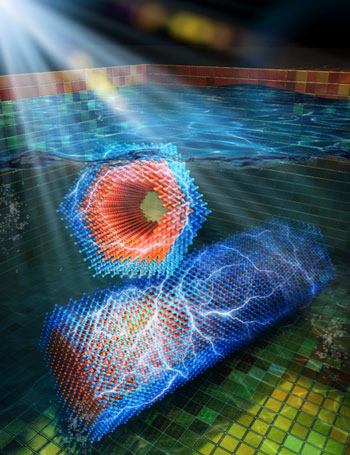| Apr 25, 2019 | |
Tellurium@Selenium nanotube heterojunctions as promising material for photodetectors |
|
| (Nanowerk Spotlight) Over the past decade, monoelemental tellurium (Te) has attracted great interest among researchers due to its intriguing properties of excellent photoresponse, fast photoconductivity, high thermoelectricity, and piezoelectricity. | |
| However, the chemical instability of Te in harsh conditions, for instance an acidic environment, and its limited optical absorption limits severely affects the performance of Te-based nanomaterials in practical device applications, in particular for photodetection. | |
| Due to their multifunctionality, heterojunction nanocomposites between different materials have exhibited great potential for their applications in photodetectors, piezoelectric nanogenerators, and solar cells. For instance, heterojunction nanocomposites incorporating tellurium have shown remarkable improvements in thermoelectric device performance. | |
| In a new study, led by Professor Han Zhang at Shenzhen University in China, and published in Small ("Enhanced Photodetection Properties of Tellurium@Selenium Roll-to-Roll Nanotube Heterojunctions"), researchers demonstrate, for the first time, a tellurium@selenium (Te@Se) heterostructure used as a working material in a photoelectrochemical (PEC)-type photodetector. | |
| Specifically, (Te@Se) roll-to-roll nanotube heterojunctions synthesized by epitaxial growth of selenium on tellurium nanotubes exhibit a largely enhanced self-powered photoresponse, significantly improved photocurrent density, and photoresponsivity compared to those of Te or Se nanomaterials. | |
| Theses structures also present excellent stability, no matter where they were tested in ambient/harsh conditions, indicating great potential for the practical applications. | |
 |
|
| Te@Se was, for the first time, used as a photoelectrochemical-type device absorber, exhibiting excellent broadband photodetection and stability (Image: Dr. Weichun Huang, Dr. Ye Zhang, Shenzhen University) | |
| In this work, Se was selected as the other component to form Te/Se heterostructure based on a few considerations. 1) Se belongs to the same group as Te in the periodic table, which has similar anisotropic and isomorphous characteristics. 2) As an important semiconductor, Se has shown many remarkable properties for band-gap engineering, photodetection, and nonlinear optical responses. 3) Se has good electrochemical stability for practical applications compared to Te. | |
| As a result, the photocurrent density and photoresponsivity of Te@Se-based photodetector can reach 7.79 µA cm-2 and 98.8 µA W-1, respectively, both of which significantly outperform reported Se nanosheets-based or Te nanosheets-based photodetectors, indicating its promising advantages for application in PEC-type photodetectors. | |
| In addition, after Se growth on the Te nanotubes, the self-powered photoresponse performances significantly improve, compared to individual Te or Se nanomaterial-based photodetector. This is mainly attributed to the advantages of the heterojunction, which creates a built-in electric field as a driving force to efficiently separate photogenerated electron-hole pairs and thus makes devices more reliable and energy efficient. | |
| More importantly, distinct from Te nanotubes and Se nanosheets, Te@Se samples are very stable in acidic, neutral, and basic solutions. It is notable that there are only 7.33%, 11.1%, and 15.8% reductions of photocurrent density in 0.5 M HCl, NaCl, and KOH, respectively, remarkably superior to the previously reported that of ultrathin Te nanosheets. This suggests a very intriguing photoresponse behavior stability of Te@Se under ambient or harsh conditions. | |
| We believe that the novel Te@Se-based photodetectors can pave the way for new designs of heterostructures for high-performance optoelectronic devices. | |
|
Provided by Shenzhen Engineering Laboratory of Phosphorene and Optoelectronics, Shenzhen University, as a Nanowerk exclusive
|
|
|
Become a Spotlight guest author! Join our large and growing group of guest contributors. Have you just published a scientific paper or have other exciting developments to share with the nanotechnology community? Here is how to publish on nanowerk.com. |
|
